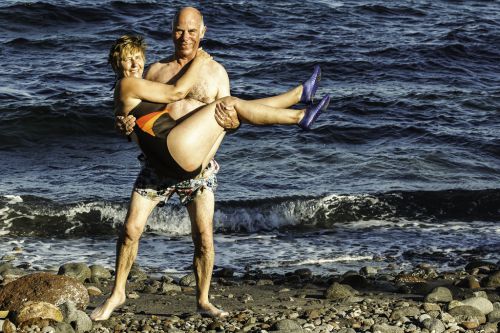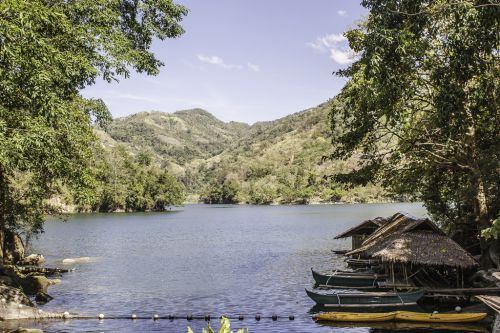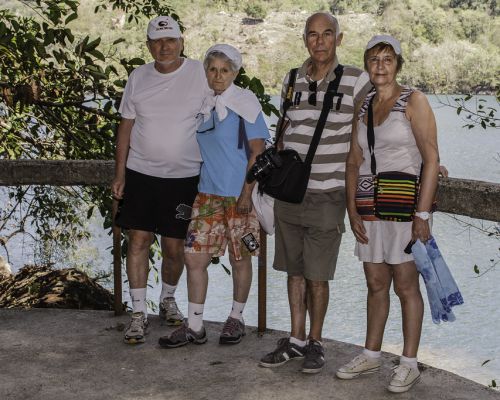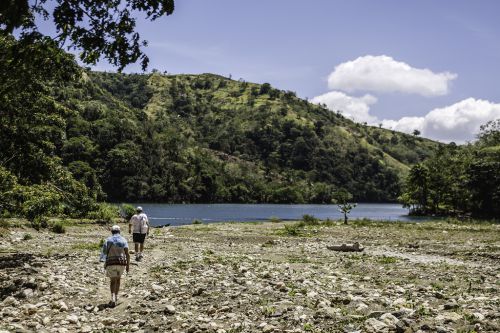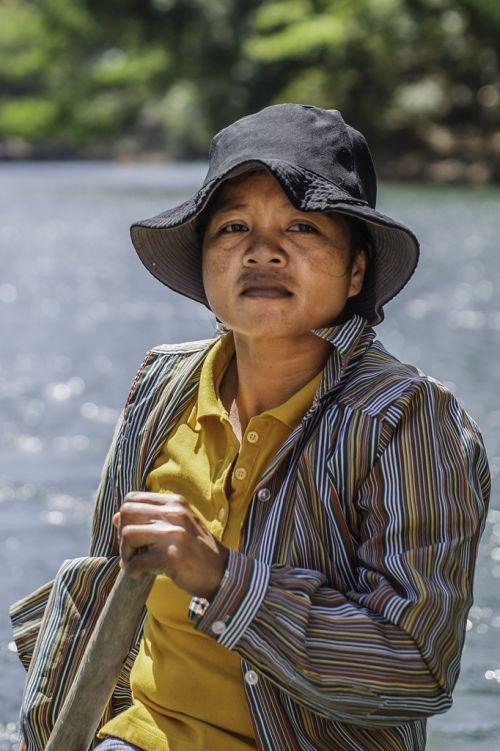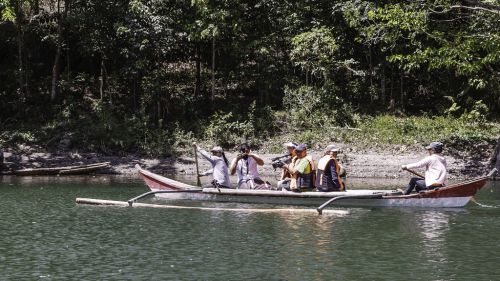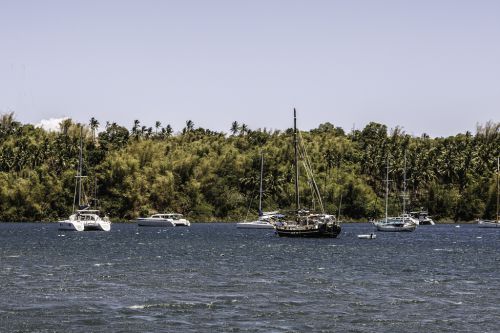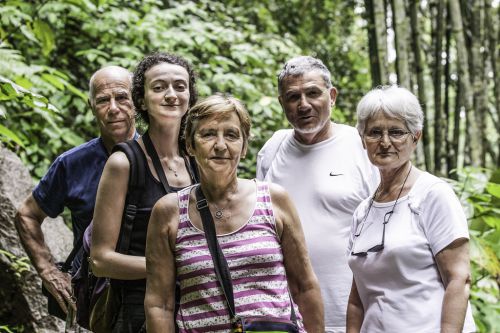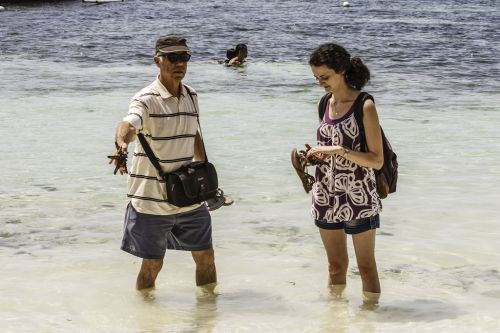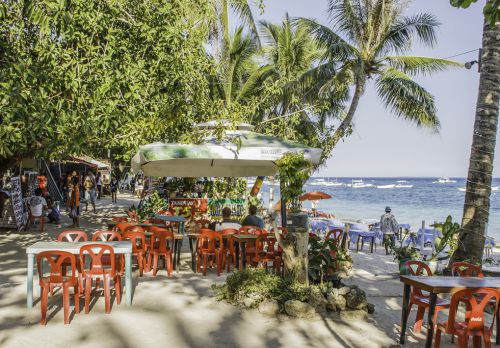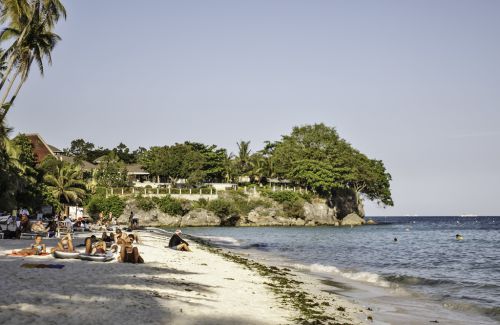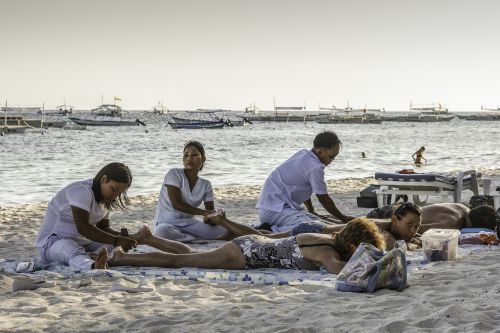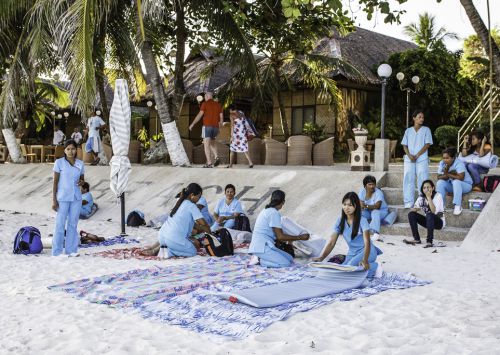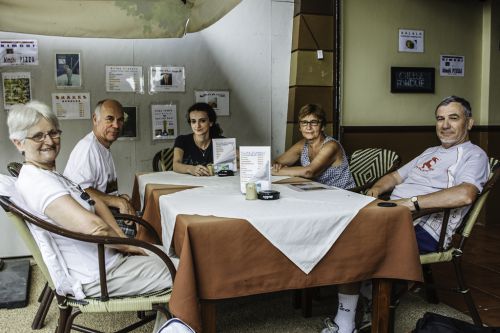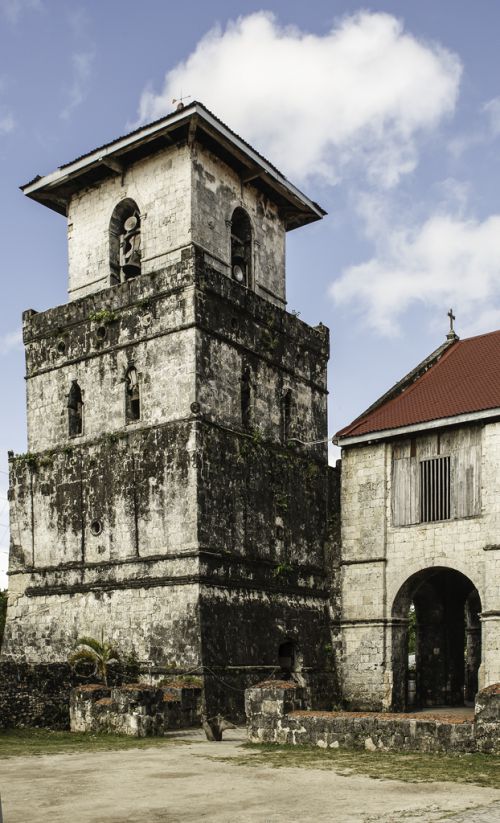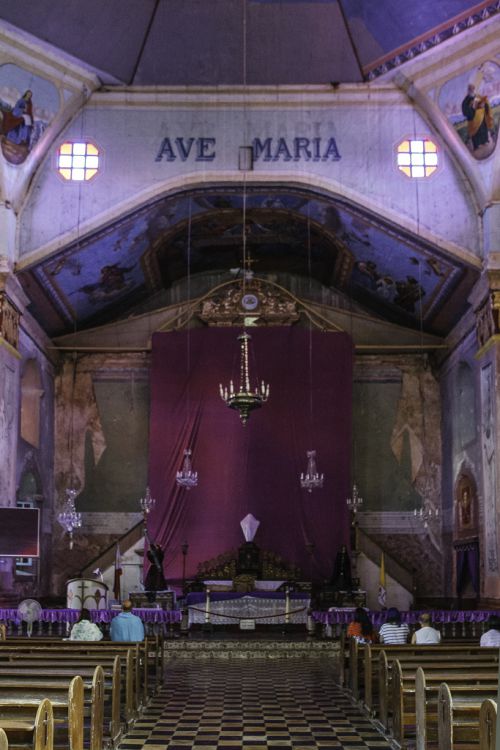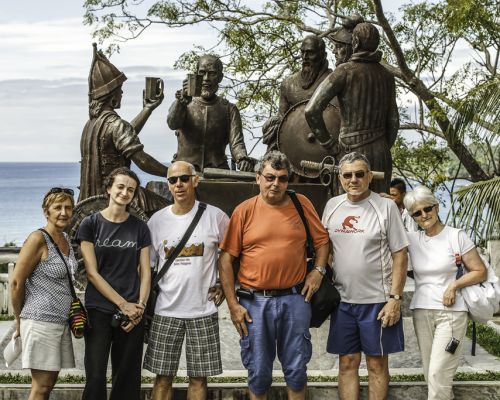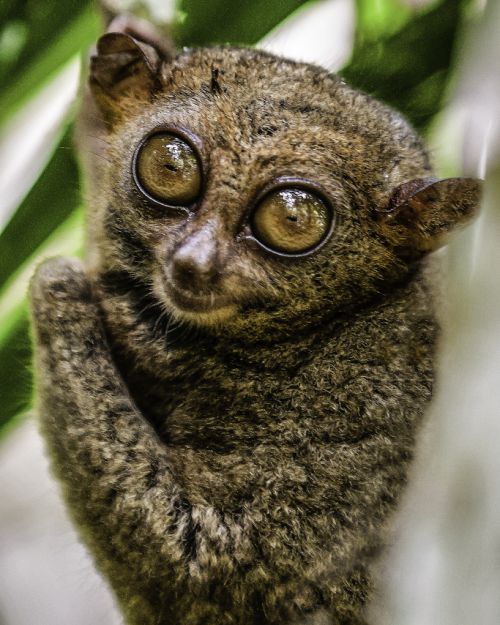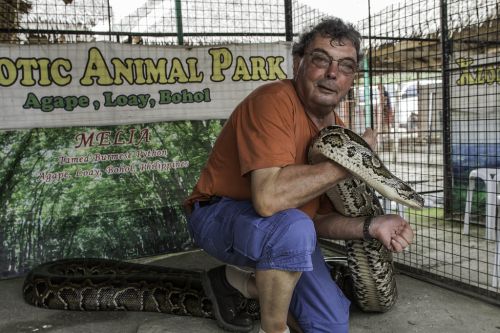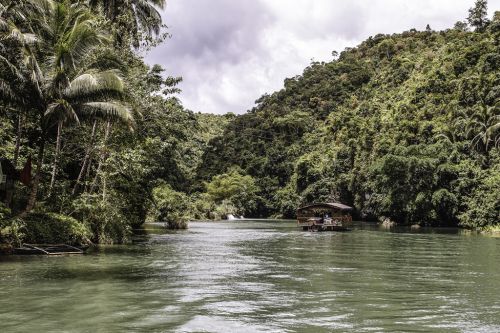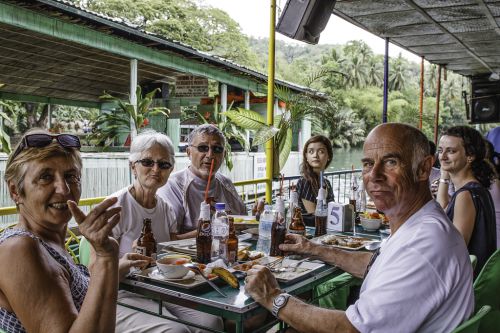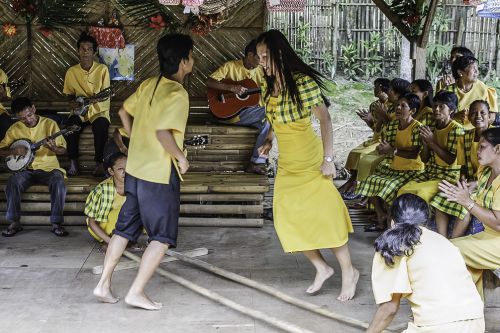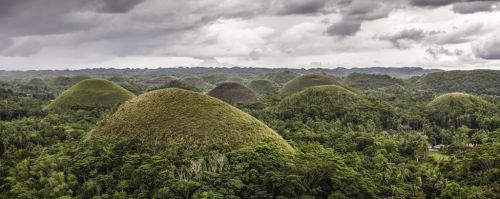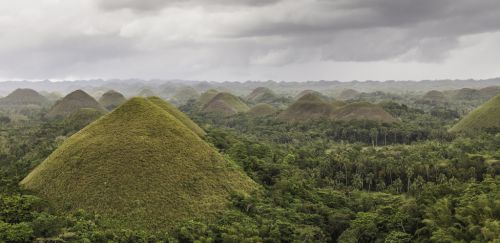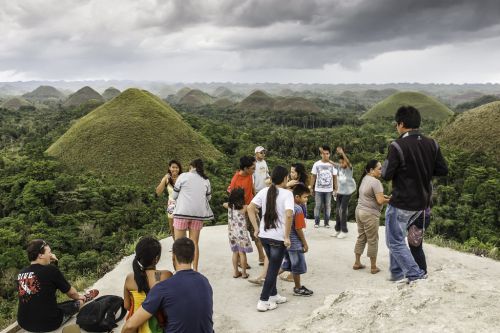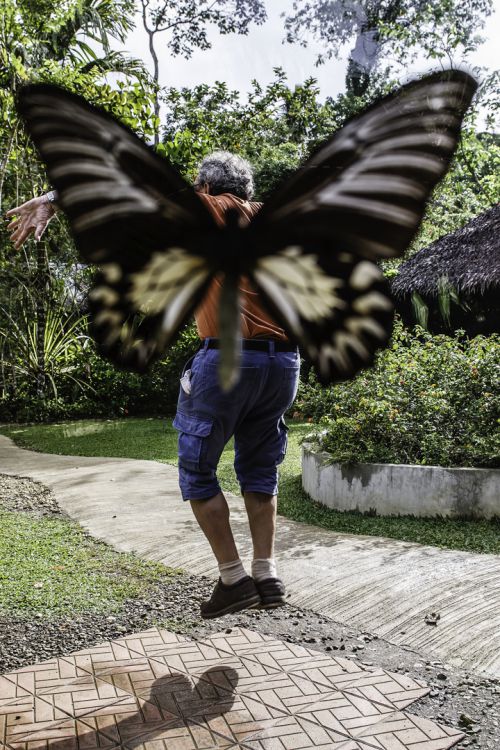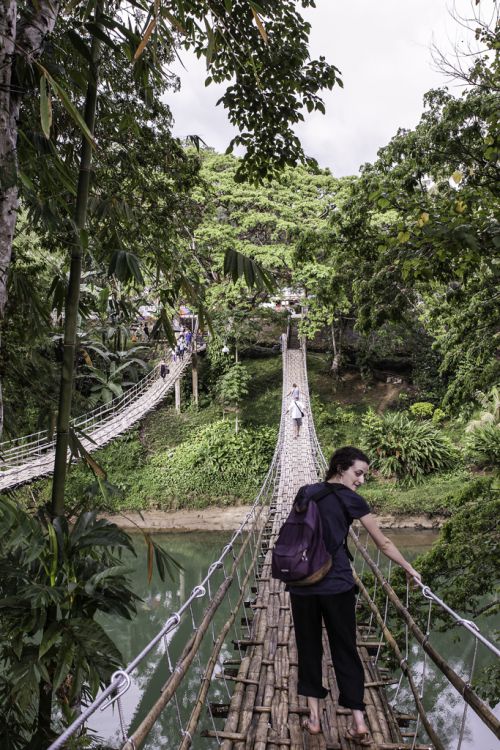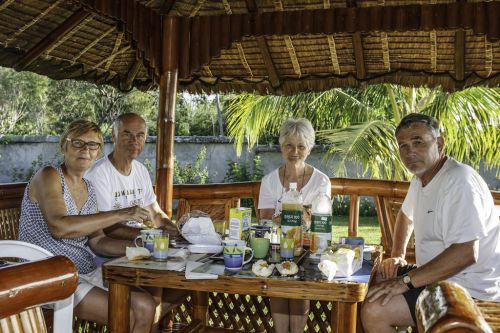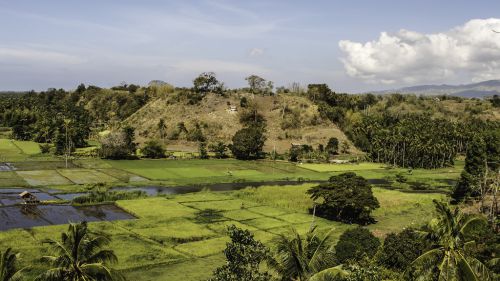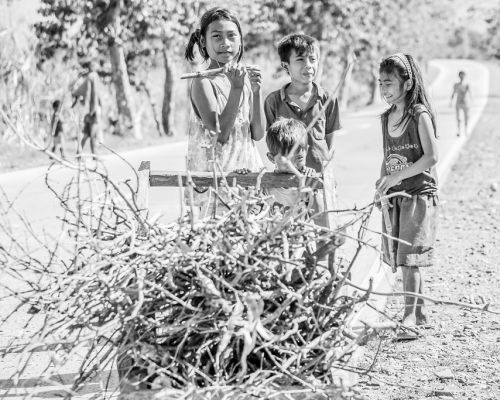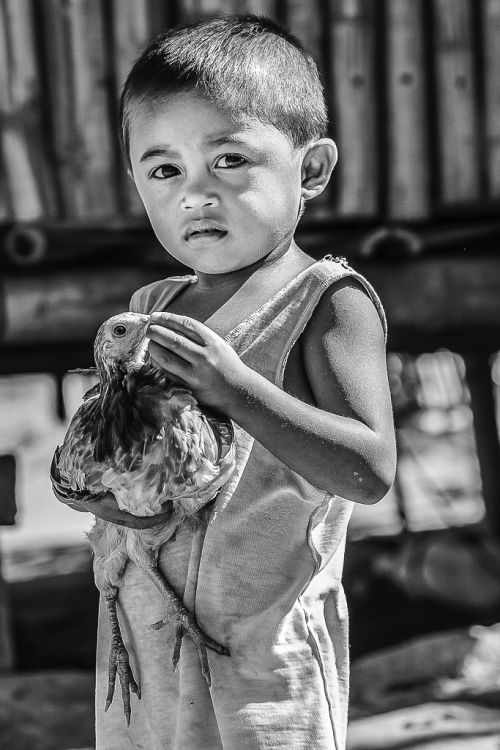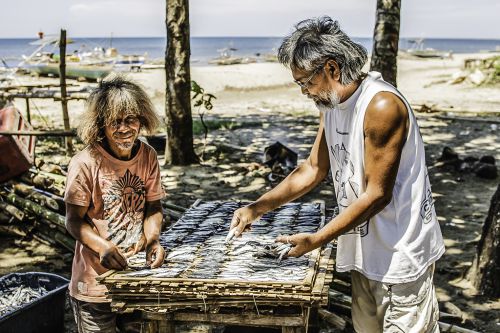March 2013 (continuation). Tourism with my friends in Negros Oriental and Bohol
So we arrived on March 12 in evening at the Mag-abo house except for Anne-Lise our 24-year-old classmate's daughter to join us a few days later.
There, my way of life surprised them very pleasantly. They discovered a modern big house with a lawn of 3000 square meters. They had a mountain view at the back and at the front they just had to open the gate on the beach to swim in the sea at 26-28 °C.
Most often, except for a few errands in town, staying at home with some swimming, afternoon nap and Nora's cooking were enough for their happiness.
(Marie-Thérèse and Daniel)
Nevertheless, it would have been a pity for them not to do some sightseeing in the area and I made a point of honor to guide them.
For our first day out, I took them first to Balanan Lake about 40 km from the house. There is a 10 kilometers trail to go up there from the highway. Isolated in the mountains, the lake is a real reserve of fresh water fed by numerous rivers, a depth of 140 meters and an area of 25 hectares. Swimming is still forbidden since the accidental drowning a few years ago of a Singaporean tourist. For that, there is a swimming pool nearby.
(Balanan Lake)
For the first time I hired a boat to tour the lake with my friends but it's amazing because only women are maneuvering and paddling the outriggers with tourists. I guess the men are working the fields meanwhile.
(Touring the lake in canoes)
(A waterfall for the lake)
Then to please Daniel who loves and owned a sail boat before, we went to the Tombobo Bay to admire the yachts that came mooring here during their course across oceans taking shelter or making some repairs.
(The sailboats at Tombobo Bay)
Then it was lunchtime and we went to a small resort off the beaten track, the Kookoo's Nest Resort run by a Londoner to enjoy, not a Filipino dish, but its famous fish and chips.
http://kookoosnest.com.ph/
Four days later we wanted to visit the Casadoro Falls above Valencia. To reach the falls we have to go down the stairs with its 350 steps but it is especially while climbing back up that we have an exact idea of our own physical condition and age. It was bad luck, because once down, it was not possible to go any further as the previous day's rains had so swelled the river that it had become dangerous.
(The mountain stream swollen with water rains)
(Disappointed but we have to climb back up the stairs and its 350 steps)
The next day we had planned to visit a part of the island of Bohol.
At 5:30 am a tricycle was waiting at the entrance of the house to take us to the Dumaguete pier where at 7 am we boarded the fast craft bound to Tagbilaran, capital of Bohol, where we arrived an hour and half later.
Once there, the van of Paragayo Resort where I had booked the rooms was waiting to take us to Alona Beach on Panglao Island.
Alona Beach only 30 minutes drive from Tagbilaran, is the top local tourist attraction with its white sand beach about 1.5 km long and its countless hotels and restaurants. It is also the starting point for all excursions in the region.
Paragayo Resort is located 250 meters off the beach and offer clean and comfortable standard rooms to 1600 pesos per night (30 Euros).
http://www.panglaoisland.net/paragayoresort/
This first day was only devoted to relax and enjoy the beach with its special atmosphere totally dedicated to tourism and diving.
(Discovering Alona Beach and the colored starfishes)
(A tourists paradise)
The next day I had rented a van for 5 people for 2500 pesos (47 Euros) to do the classic tour of Bohol.
After a hearty breakfast served in the Swiss restaurant next door, we left at 7:30 am.
(Breakfast at the Swiss restaurant)
We went first to visit the Baclayon Church, built by the Jesuits in 1595 and the second oldest church in the Philippines after St. Augustine Church in Manila.
(Baclayon Church)
Just in front, just by the sea, there is a monument called the Blood Compact and part of the essential tourist places. It commemorates the alliance of the Filipino Chief Datu Sikatuna and the Spaniard Don Miguel Lopez de Legazpi. They drank each other blood mixed with wine and thus they sealed, March 16, 1565, the first friendship treaty ever signed between a European and an Asian.
(Our group in front of the Blood Compact monument)
I then insisted heavily with our guide and driver to see the tarsiers in the reserve of Corrella Center and not in cages along the Loboc river where they are just pulled out for photo with tourists and this is where we went next.
The Corella Center is is a reserve of 10 hectares where around one hundred tarsiers live. Of which, only one hectare populated with 10 specimens is open to public with limited visitors.
These 10 tarsiers are not always visible as they change places every night and the guide is not always aware of their new location therefore that morning there was only six to see.
The tarsier is nocturnal so the guide recommended not being noisy, not to abuse photos and of course without using a flash.
The tarsier is the oldest primate in the world whose origins date back to forty-five million years. We can still find them only in two places in Asia, Bohol Island and a small part of Borneo. Their height is only 12 to15 centimeters and they are nocturnal and solitary animals eating only insects. They only live in couple the time of mating and bear only one offspring per year.
As endangered species, his eyes seemed to implore us to let him live in peace and free.
(The tarsier with such a touching look)
Lunchtime was approaching, but before we stopped to see some local animals and especially pythons. Not wanting to be outdone with my wife who a few years ago put a giant one around her neck as a scarf, I entered the cage to hug a beautiful beast of 250 kilos just for the photos.
(I am holding a 250 kilos python)
Our lunch buffet happened on local riverboats plying the Loboc River and we had a good time enjoying both the cruise and the delicious meal.
(The cruise and the lunch on the Loboc River)
(The villagers make a living with some folk dancing)
(and souvenir)
After the tarsiers, it was now the second biggest highlight of the day with the visit in Carmen of the Chocolate Hills.
This is an unusual geological formation of 1268 cone-shaped hills of similar size spread over 50 square kilometers. It owes its name to its vegetation, which turns brown in the dry season.
Their forming underwater dates back about two million years and is due to the accumulation of successive layers of coral and shells. Thereafter, the plate tectonics made to remove the sea and the hills could emerge out of the water.
From there, erosion from rain and wind gave the Chocolate Hills their types of cones and balls shapes.
(Chocolate Hills)
Their heights vary from 30 meters to 50 meters and the Philippines have already proposed the site for inclusion on the list of UNESCO World Heritage.
(One of the most visited tourist spots in the Philippines)
For twelve years it was my sixth visit to the Chocolate Hills and believe me or not but I have never seen or photographed them by a sunny day with a clear blue sky. The day before the weather was good the next day as well, but during our visit, the sky was overcast and of course, we got our tropical downpour.
Well, I should visit here again with another group of four friends next year so who knows.
It is under the rain that we continued our tour and then visit the Butterfly Farm with our wings a little wet.
(The butterfly farm)
(I am trying to fly with my new wings)
We finished the day with the hanging bamboo bridge over the Loboc River. This bridge can hold ten people at the same time so before the increased number of visitors, the government decided to add a second. Now we have one for each way.
(The hanging bridges)
The next day we were back in Dumaguete then to the house of Mag-abo. I hope that my friends have now nice and happy memories of Bohol.
Only eight days were left before our return to Manila. Apart from relaxing at home, a few errands and the Wednesday Malatapay market, I suggested that they had one more road trip just to enjoy the scenery of southern Negros.
(Breakfast in the Mag--abo cottage by the sea)
Therefore, on March 26, we set off to Bayawan, 75 kilometers from home. We drove slowly taking our time and making frequent stops. It was only after a good lunch that we took the road back.
(Some views)
(and some encounters)
We left to Manila on Goof Friday and my small group flew back to Europe on Black Saturday to arrive in Paris on Easter Sunday, except for Anne Lise who still had two weeks to spend in Vietnam.
(A bit sad while waiting the flight to Manila at the Dumaguete airport)
I felt now alone but relieved as everything went smoothly, nobody got sick and they all enjoyed their stay in the Philippines.
A découvrir aussi
- Letter 1: Poor Luisa. Update, 2007.07.07
- 2- My September trips: Dapitan, Bayawan and Cebu city
- September 15 to November 2, 2014 (Last part or at the risk of repeating myself: Cousin Eddie Birthday, Mag-abo, Thalatta, Bohol, Balanan Lake, Malatapay market, Mabolo Falls, Rovie's birthday, Bayawan and Basay.)
Inscrivez-vous au blog
Soyez prévenu par email des prochaines mises à jour
Rejoignez les 21 autres membres

